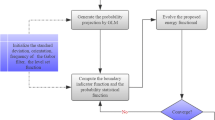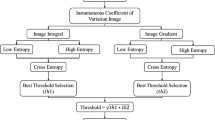Abstract
Abundant noise, low contrast, intensity heterogeneity, shadows, and blurry boundaries exist in most medical images, especially for 2D ultrasound (US) image. In this paper, we propose a semiautomatic hybrid active contour model for 2D US image segmentation. The proposed method mainly uses a local bias correction function and probability score. It is well known that most region-based active contour models are based on the assumption of intensity homogeneity. It is very difficult to define a region descriptor for US images with intensity heterogeneity. Here, a bias field can account for the intensity heterogeneity of the US image. Therefore, the proposed local bias correction function is considered to integrate with respect to the neighborhood center of the US image. Besides, to segment complex ultrasound images more accurately, a probability score is constructed from the edge-based operator. Based on the estimation of the bias field and an interleaved process of probability score, minimization of the proposed energy functional is achieved. The proposed method is validated on synthetic images and real US images, with satisfactory performance in the presence of noise, intensity heterogeneity, and blurry boundaries.










Similar content being viewed by others
References
Billings S, Albayda J, Burlina P (2017) Ultrasound image analysis for myopathy detection. In: The 23rd international conference on pattern recognition, pp 1461–1465
Brox T, Weickert J (2006) A tv flow based local scale estimate and its application to texture discrimination. J Vis Commun Image R 17:1053–1073
Buades A, Coll B, Morel JM (2005) A non-local algorithm for image denoising. In: IEEE conference on computer vision and pattern recognition, pp 60–65
Caselles F, Coll T et al (1993) A geometric model for active contours in image processing. Numer Math 66:1–31
Caselles V, Kimmel R, Sapiro G (1997) Geodesic active contours. Int J Comput Vis 22(1):61–79
Chan TF, Vese LA (2001) Active contours without edges. IEEE Trans Image Process 10(2):266–277
Chunming L, Chenyang X, Changfeng G et al (2005) Level set evolution without re-initialization: a new variational formulation. IEEE conference on computer vision and pattern recognition (CVPR), pp 430–436
Chunming L, Chiu YK, Gore JC et al (2007) Implicit active contours driven by local binary fitting energy. In: IEEE conference on computer vision and pattern recognition, pp 1–7
Chunming L, Chiu-Yen K, Gore JC et al (2008) Minimization of region-scalable fitting energy for image segmentation. IEEE Trans Image Process 17(10):1940–1949
Chunming L, Huang R, Ding ZH et al (2011) A level set method for image segmentation in the presence of intensity inhomogeneities with application to MRI. IEEE Trans Image Process 20(7):2007–2016
Darolti C, Mertins A, Bodensteiner C et al (2008) Local region descriptor for active contours evolution. IEEE Trans Image Process 17(12):2275–2288
Dubuisson MP, Jain AK (1994) A modified Hausdorff distance for object matching. Int Conf Pattern Recogn 1:566–568
Dym CL, Shames IH (2014) Introduction to the calculus of variations: Solid Machanics, 3rd edn. pp 71–116
Elder J, Zucker S (1998) Local scale control for edge detection and blur estimation. IEEE Trans Pattern Anal Mach Intell 20(7):699–716
Faisal A, Ng SC, Goh SL et al (2015) Multiple LREK active contours for knee meniscus ultrasound image segmentation. IEEE Trans Med Imaging 34(10):2162–2171
Fang L, Qiu T, Liu Y et al (2018) Active contour model driven by global and local intensity information for ultrasound image segmentation. Comput Math Appl 75:4286–4299
Faust O, Acharya UR, Sudarshan VK et al (2017) Computer aided diagnosis of coronary artery disease, myocardial infarction and carotid atherosclerosis using ultrasound images: a review. Physica Med 33:1–15
Foster B, Bagci U, Mansoor A et al (2014) A review on segmentation of positron emission tomography images. Comput Biol Med 50:76–96
Gupta D, An RS (2017) A hybrid edge-based segmentation approach for ultrasound medical images. Biomed Signal Process Control 31:116–126
Gupta D, An RS, Tyagi B (2015) A hybrid segmentation method based on Gaussian kernel fuzzy clustering and region based active contour model for ultrasound medical images. Biomed Signal Process Control 16:98–112
Huttenlocher DP, Klanderman GA, Rucklidge WJ (1993) Comparing images using the Hausdorff distance. IEEE Trans Pattern Anal Mach Intell 15(9):850–863
Kass M, Witkin A, Terzopoulos D (1988) Snakes: active contour models. Int J Comput Vis 1(4):321–331
Lankton S, Tanenbaum A (2008) Localizing region-based active contours. IEEE Trans Image Process 17(11):2029–2039
Leung C, Hashtrudi-Zaad K, Foroughi P et al (2009) A real-time intrasubject elastic registration algorithm for dynamic 2-D ultrasound images. Ultrasound Med Biol 35(7):1159–1176
Li C, Gore JC, Davatzikos C (2014) Multiplicative intrinsic component optimization (MICO) for MRI bias field estimation and tissue segmentation. Magn Reson Imaging 32(7):913–923
Liu SG, Peng YL (2012) A local region-based Chan-Vese model for image segmentation. Pattern Recogn 45(7):2769–2779
Meiburger KM, Acharya UR, Molinari F (2018) Automated localization and segmentation techniques for B-mode ultrasound images: a review. Comput Biol Med 92:210–235
O’Shea T, Bamber J, Fontanarosa D et al (2016) Review of ultrasound image guidance in external beam radiotherapy part II: intra-fraction motion management and novel applications. Phys Med Biol 61(8):R90–R137
Phumeechanya S, Pluempitiwiriyawej C, Thongvigitmanee S (2010) Active contour using local regional information on extendable search lines (LRES) for image segmentation. IEICE Trans Inf Syst E 93(6):1625–1635
Rakesh RR, Chaudhuri P, Murthy C (2004) Thresholding in edge detection: a statistical approach. IEEE Trans Image Process 13(7):927–936
Wang L, Pan C (2014) Robust level set image segmentation via a local correntropy-based K-means clustering. Pattern Recogn 47(5):1917–1925
Wang L, Chang Y, Wang H et al (2017) An active contour model based on local fitted images for image segmentation. Inf Sci 418:61–73
Wang L, Zhu J, Sheng M et al (2018) Simultaneous segmentation and bias field estimation using local fitted images. Pattern Recogn 74:145–155
Yuan J (2012) Active contour driven by region-scalable fitting and local bhattacharyya distance energies for ultrasound image segmentation. IET Image Process 6(8):1075–1083
Yuan J (2013) Active contour driven by local divergence energies for ultrasound image segmentation. IET Image Process 7(3):252–259
Zang X, Bascom R, Gilbert C et al (2015) Methods for 2D and 3D endobronchial ultrasound image segmentation. IEEE Trans Biomed Eng 63(7):1426–1439
Zhang HL, Ye XJ, Chen YM (2013) An efficient algorithm for multiphase image segmentation with intensity bias correction. IEEE Trans Image Process 22(10):3842–3851
Zhan TM, Zhang J, Xiao L et al (2013) An improved variational level set method for MR image segmentation and bias field correction. Magn Reson Imaging 31(3):439–447
Funding
This study was funded by the National Natural Science Foundation of China (grant number 61801202), Provincial College Students Innovation and Entrepreneurship Training Program, and Undergraduate Scientific Research Training Projects Guided by Teachers (Grant Number CX201902022).
Author information
Authors and Affiliations
Corresponding author
Ethics declarations
Conflict of interest
Author Lingling Fang declares that she has no conflict of interest. Author Xiaohang Pan declares that she has no conflict of interest. Author Yibo Yao declares that he has no conflict of interest. Author Lirong Zhang declares that she has no conflict of interest. Author Dongmei Guo declares that she has no conflict of interest.
Ethical approval
This article does not contain any studies with human participants performed by any of the authors.
Additional information
Communicated by V. Loia.
Publisher's Note
Springer Nature remains neutral with regard to jurisdictional claims in published maps and institutional affiliations.
Appendices
Appendix A. Modeling of the proposed energy term and its solution
The proposed energy functional term is defined as:
The parameters used here are defined:
For pixel \( y \in \varOmega \), an energy functional is
Assume the evolution curve \( C \) is divided \( \varOmega \) into two regions:
The sum of intensity is
The average intensity is
The optimal level set \( \phi \) of the proposed segmentation problem is transformed into the minimization of Eq. (17):
Appendix B. Solution of the proposed energy term
To solve the above equation, the following partial derivatives are calculated firstly:
and
where \( {\mathbf{1}} \) denotes a constant matrix with value 1.
For convenience, we suppose
So
The final curve evolution is yielded:
Rights and permissions
About this article
Cite this article
Fang, L., Pan, X., Yao, Y. et al. A hybrid active contour model for ultrasound image segmentation. Soft Comput 24, 18611–18625 (2020). https://doi.org/10.1007/s00500-020-05097-y
Published:
Issue Date:
DOI: https://doi.org/10.1007/s00500-020-05097-y




